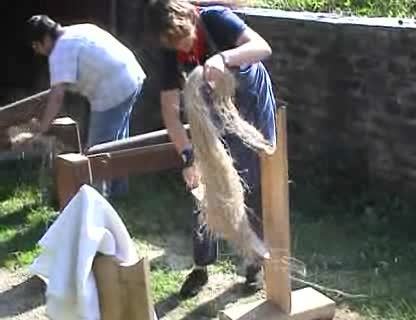 | ||
Scutching is a step in the processing of cotton or the dressing of flax in preparation for spinning. The scutching process separates the impurities from the raw material, such as the seeds from raw cotton or the straw and woody stem from flax fibers. Scutching can be done by hand or by a machine known as a scutcher. Hand scutching of flax is done with a wooden scutching knife and a small iron scraper. The end products of scutching flax are the long flax fibers, short coarser fibers called tow and waste woody matter called shive.
Contents
In the early days of the cotton industry the raw material was manually beaten with sticks after being placed on a mesh, a process known as willowing or batting, until the task was mechanised by the development of machines known as willowers. Scutching machines were introduced in the early 19th-century, and processed the raw material into a continuous sheet of cotton wadding known as a lap.
Cotton scutching
Before cotton is processed it has to be cleaned of its seeds and other impurities, which in the early days was done by spreading the raw cotton on a mesh and beating it with sticks, a process known as willowing or batting. A scutching machine for cotton, known as a scutcher, was invented in 1797, but did not get much attention until it was introduced in Manchester cotton mills in 1808 or 1809. By 1816 scutchers had been generally adopted.
The scutching machine passes the cotton through a pair of rollers, then strikes it with iron or steel bars called beaters. The beaters, which turn very quickly, strike the cotton hard and knock the seeds out. This process is done over a series of parallel bars, allowing the seeds to fall through. At the same time air is blown across the bars, which carries the cotton into a cotton chamber. The end result is a continuous sheet of cotton wadding known as a lap, ready for the next stage of the production process, carding.
By hand
The scutching knife is scraped down with a sharp strike against the fibers while they hang vertically. The edge of the knife is scraped along the fibers to pull away pieces of the stalk. This is repeated until all of the stalk has been removed and the flax is smooth and silky. When scutching was done by hand people could scutch up to 15 pounds (6.8 kg) of flax in one day, though the amount depended on the quality of the flax. Coarser flax, harder flax and poorly retted flax takes longer to scutch. Retting removes the pectins that bind the fibers to the stalk and each other, so under-retted flax is harder to separate from the stalk, and often gets damaged in the scutching process. Over-retting the flax causes the fibers to deteriorate and break.
In the scutching process some of the fiber is also scutched away along with the stalk, a normal part of the process.
By machine
Scutching is done several ways by machine. Scutching mills started in Ireland, and were commonly used there by 1850, at a time when hand scutching was still common in Continental Europe. Machine scutching, while faster and cheaper, causes more waste than scutching by hand. One method of machine scutching is to crush the stalks between two metal rollers so that parts of the stalk can be separated.
A modern scutching machine can process up to 500 kilograms (1,100 lb) of flax every hour, and produces about 70 kilograms (150 lb) of flax fibers and 30 kilograms (66 lb) of tow. Older machines create more waste.
